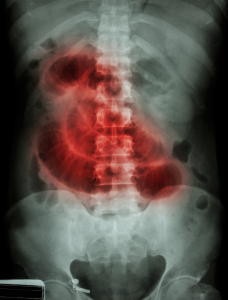Introduction
This strange word, volvulus, has nothing to do with the car “Volvo”. Volvulus derives from the Latin word “volvere” meaning to roll or to turn. It occurs when a bowel loop gets twisted upon itself thus causing bowel obstruction. This can be inborn (congenital) in a newborn child or develop in adult life.
The congenital form is usually a sign that there was a malrotation. This means that the gut interrupted the normal embryonic rotation. Often the cecum (fist part of the colon) or a small bowel loop is twist themselves around its blood supply. This is a surgical emergency as there are only a few hours to rescue the gut and the child.
The acquired form in the adult presents dramatically as well, but it affects only the large bowel, either the cecum twisted around itself or the sigmoid colon where the colon forms a natural loop, which is prone to volvulus formation particularly in older patients. This leads to bowel obstruction of the colon. However, it can also happen in the mid gut (mid gut volvulus) as a complication following gastric bypass surgery or following ventral hernia repairs.
Symptoms
A newborn cannot express itself too well, but the mother will pick up a different cry signalling distress, which makes her concerned. Also, the baby will not settle, but continue to scream. The infant will then vomit bile because of the bowel obstruction. The baby looks very ill at that point and very likely the parents bring it to the Emergency Room of the hospital for an assessment. Plain X-rays of the abdomen show hardly any normal gas pattern. A Barium enema shows that the cecum location is not in the right lower abdomen. The pediatric surgeon will assess the baby and will urgently repair this defect.
In the adult symptoms start with right (cecum) or left (sigmoid) lower abdominal pain coupled with vomiting and a lack of stool production due to the bowel obstruction. Patients with cecal volvulus are usually younger than patients with sigmoid volvulus. Gangrene of the twisted bowel loop brings with it the danger of rupture and peritonitis. A colonoscopy can sometimes decompress the volvulus, but surgery needs to follow soon. A barium enema is often done as a diagnostic test as it can often pinpoint the site of obstruction. However, if the gangrenous bowel perforates, a nasty Barium peritonitis would develop, which would trouble the patient for years to come due to extensive scarring.
Treatment
Once a volvulus is diagnosed, treatment is usually surgical. The general surgeon may decide to decompress the bowel first by doing a preliminary colostomy (an artificial opening to the colon through the skin) just to decompress the bowel.
Each situation is different and the surgeon will choose the method that is best suited for the situation. Most of the time the surgeon will remove the gangrenous bowel loop of the volvulus and do an end-to-end reconnection (called “anastomosis”) of the severed colon. On other occasions the volvulus may not have led to gangrene and can be twisted back into the normal position of the gut. However, the surgeon may decide to stitch the bowel into place so that the volvulus does not reform in future.
References
1. DM Thompson: The 46th Annual St. Paul’s Hospital CME Conference for Primary Physicians, Nov. 14-17, 2000, Vancouver/B.C./Canada
2. C Ritenbaugh Curr Oncol Rep 2000 May 2(3): 225-233.
3. PA Totten et al. J Infect Dis 2001 Jan 183(2): 269-276.
4. M Ohkawa et al. Br J Urol 1993 Dec 72(6):918-921.
5. Textbook of Primary Care Medicine, 3rd ed., Copyright © 2001 Mosby, Inc., pages 976-983: “Chapter 107 – Acute Abdomen and Common Surgical Abdominal Problems”.
6. Marx: Rosen’s Emergency Medicine: Concepts and Clinical Practice, 5th ed., Copyright © 2002 Mosby, Inc. , p. 185:”Abdominal pain”.
7. Feldman: Sleisenger & Fordtran’s Gastrointestinal and Liver Disease, 7th ed., Copyright © 2002 Elsevier, p. 71: “Chapter 4 – Abdominal Pain, Including the Acute Abdomen”.
8. Ferri: Ferri’s Clinical Advisor: Instant Diagnosis and Treatment, 2004 ed., Copyright © 2004 Mosby, Inc.







